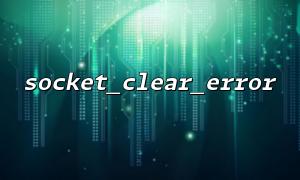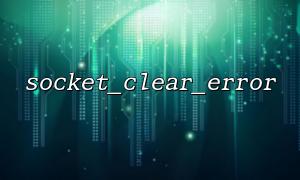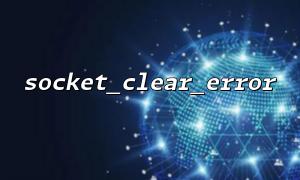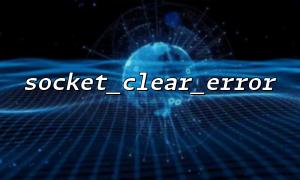Debugging and troubleshooting errors is often a time-consuming and laborious task when programming PHP-based sockets. To help developers more effectively track and clear socket-related error information, PHP provides a built-in function: socket_clear_error() . This article will introduce how to use this function, as well as its role and advantages in the actual debugging process.
During socket operation, if an error occurs, PHP will record the information about the last socket error. We can get this information through the socket_last_error() function and convert it into a readable error description using socket_strerror() . However, if these error records are not cleared in time, confusion and misjudgment may occur in subsequent socket operations.
For example, if you perform data interactions multiple times in a long connection, and an operation failed in the middle but did not reset the error state, then when you call socket_last_error() later, what you might get from the last error message, not the latest state. This can lead to misleading in troubleshooting problems.
The function of socket_clear_error() is to clear the most recent socket error status to ensure that subsequent error checks will not be interfered with by historical errors.
void socket_clear_error ([ resource $socket ] )
$socket (optional): If the socket resource parameter is provided, only the error status on that resource is cleared; if not provided, the previous global socket error status occurred.
Here is a simple example showing how to use socket_clear_error() to improve debugging efficiency:
<?php
// create socket
$socket = socket_create(AF_INET, SOCK_STREAM, SOL_TCP);
if (!$socket) {
echo "create socket fail: " . socket_strerror(socket_last_error()) . PHP_EOL;
exit;
}
// Intentionally connect an invalid address,An error occurred
@socket_connect($socket, '192.0.2.1', 9999);
$error = socket_last_error($socket);
echo "First time error message: " . socket_strerror($error) . PHP_EOL;
// Clear error
socket_clear_error($socket);
// Get the error again,Should return 0 Or empty
$error = socket_last_error($socket);
echo "Error message after clear: " . socket_strerror($error) . PHP_EOL;
// Other debugging operations can be continued
?>
In the above code, we first try to connect a fake address 192.0.2.1:9999 (this is a test IP reserved for the document, unreachable), which will trigger a socket error. Then we use socket_clear_error() to clear the error state and verify that it takes effect.
When debugging applications such as chat rooms, instant messaging services, or API gateways that require frequent establishment and disconnection, the rational use of socket_clear_error() can bring the following benefits:
More accurate error log <br> Clear the error before each operation to make sure that the log is the error of the current operation, not the last unprocessed error.
Improve debugging efficiency <br> Avoid unnecessary misjudgments and focus on analyzing the real problems.
Docking debugging tools or custom monitoring systems <br> When combined with a log system (such as ELK) or a web debugging panel, you can output a monitoring interface such as https://m66.net/logs/socket_error_log to collect real and valid error data.
socket_clear_error() is a seemingly simple but very practical function in PHP socket programming. By clearing error status in key steps, developers can obtain clearer error contexts and easier troubleshooting and system tuning. Whether during the development period or in the failure recovery after deployment and launch, it is a powerful tool to improve stability and maintainability.













